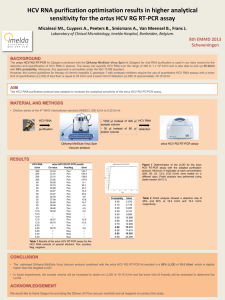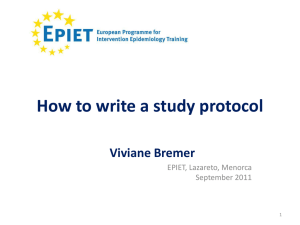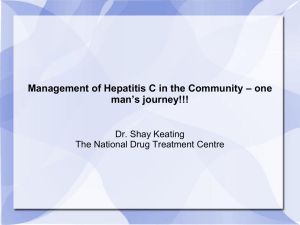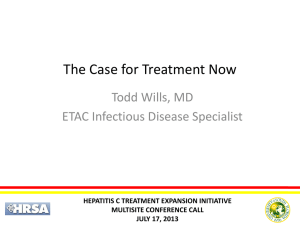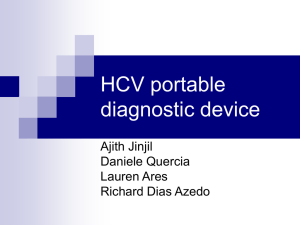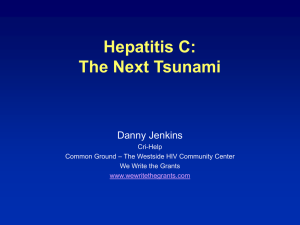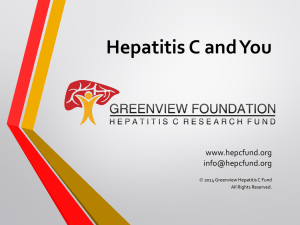A - V
advertisement
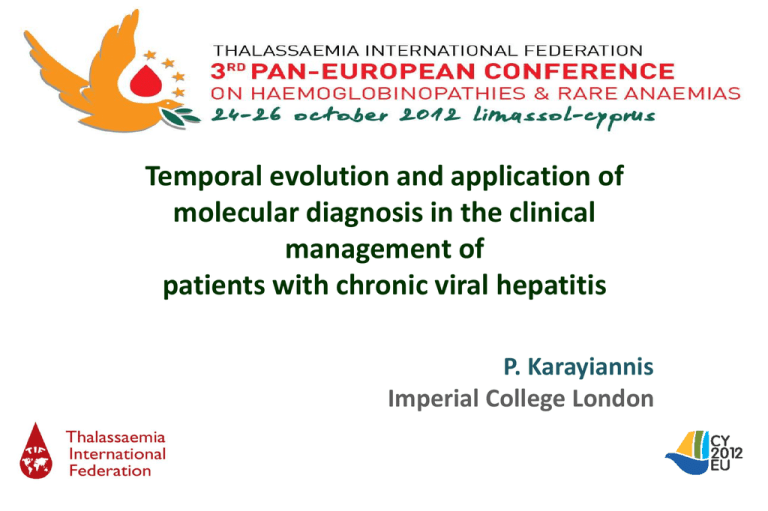
Temporal evolution and application of molecular diagnosis in the clinical management of patients with chronic viral hepatitis P. Karayiannis Imperial College London Introduction of Molecular Based Tests for the Detection of Hepatitis Viruses, Genotyping and Monitoring of Antiviral Therapy Cloning HBV HDV HAV 1970 Genotyping Nucleic acid Detection HEV HCV 1980 1990 HBV Dot-blot HDV PCR 2000 HCV SemiqPCR Real-time qPCR 2010 GENOMIC ORGANISATION OF HEPATITIS B VIRUS Hunt et al, 2000 HEPATITIS C VIRUS GENOME ORGANISATION ssRNA (9.6kb) SIGNAL PEPTIDE PEPTIDASE SIGNAL PEPTIDASE VIRALLY ENCODED PROTEASES GLYCOSYLATION SITES Moradpour et al, Nature Rev Microbiol 2007;5:453-463 Cloned HBV-DNA Hepatocyte DNA+ Restriction Enzymes Liver HBV DNA DETECTION OF HBV-DNA IN BODILY SECRETIONS BY DOT-BLOT-HYBRIDISATION AND LIVER BY SOUTHERN BLOT Kb - 2.37 HBsAg-ve HBeAg+ve anti-HBe +ve SALIVA – - 7.7 URINE – - 6.6 SEMINAL FLUID- - 4.3 SPERM - - 3.2 SERUM - - 2.2 - 2.1 Karayiannis et al, Br Med J 1985;290:1853-1855. MONITORING OF INTERFERON TREATMENT EFFICACY IN CHRONIC HBV AND HCV INFECTED PATIENTS M 1 2 3 4 5 RESPONDER NONRESPONDER Dot-blot of HBeAg +ve patient RT-PCR, 5’ NCR QUANTITATION OF NUCLEIC ACIDS BY REAL-TIME PCR Quantitative HCV RNA Assays Method Dynamic Range, IU/mL (LLOQ-ULOQ) LLOD, IU/mL LLOQ = LLOD? FDA Approved Manual RT-PCR 600-500,000 N/A N/A Yes Semiautomated RT-PCR 600-500,000 600 Yes Yes Semiautomated bDNA signal amplification 615-7,700,000 615 Yes Yes LCx HCV RNA-Quantitative Assay (Abbott Diagnostics) Semiautomated RT-PCR 25-2,630,000 23 No No SuperQuant (National Genetics Institute) Semiautomated RT-PCR 30-1,470,000 30 Yes No Cobas TaqMan HCV Test (Roche Molecular Systems) Semiautomated RT-PCR 43-69,000,000 18 No Yes COBAS TaqMan HCV Test v2.0 for use with High Pure System (Roche Molecular Systems) Semiautomated RT-PCR 25-300,000,000 15 No Yes Semiautomated RT-PCR 12-100,000,000 12 Yes Yes Assay (Manufacturer)[1] Amplicor HCV Monitor (Roche Molecular Systems) Cobas Amplicor HCV Monitor V2.0 (Roche Molecular Systems) Versant HCV RNA 3.0 Assay (bDNA) (Siemens Health Care Diagnostics) Abbott RealTime HCV Assay (Abbott Diagnostics) Note that quantitative assays may have differing or identical LLOQ and LLOD levels Phase III registration trials for both BOC and TVR used COBAS TaqMan HCV Test v2.0 for use with High Pure System (1.3% false-positive rate) Ghany MG, et al. Hepatology. 2009;49:1355-1374. Clinical Care Options, Kuo P Naeger LK, et al. Intl Workshop on Clinical Pharmacology of Hepatitis Therapy 2011. Abstract R-8. HCV RNA Assays: LLOD Is Distinct From LLOQ • LLOQ – Lowest HCV RNA concentration within linear range of assay • ie, smallest amount of HCV RNA that can be not only detected but also accurately quantified • LLOD – Lowest amount of HCV RNA concentration that can be detected with 95% probability to determine presence or absence • Beneath LLOD threshold, HCV RNA is “undetectable,” also known as “target not detected” • Commercially available quantitative assays may have differing LLOQ and LLOD levels Clinical Care Options, Kuo P HCV RNA Levels and Relationship to LLOD and LLOQ HCV Treatment Log10 Viral Titer 8 HCV RNA Assay Result: Detectable/ quantifiable 6 Reported as quantitative number within performance range of assay 4 Reported as detected 2 Detectable/not quantifiable Not quantifiable/ not detectable 1 0 0 LLOQ LLOD Reported as undetected or target not detected Time SVR Adapted from Naeger LK, et al. Intl Workshop on Clinical Pharmacology of Hepatitis Therapy 2011. Abstract R-8. Clinical Care Options DETERMINATION OR RESPONSE BASED ON HCV-RNA DETECTION AT SET POINTS DURING ANTIVIRAL TREATMENT HCV RNA (log10 IU/mL)[1] 7 Null response 6 5 Partial response 4 3 Relapse 40% chance of SVR with pegIFN/RBV[2] 2 1 Undetectable RVR 0 -8 -4 -2 0 4 EVR 8 12 EOT 16 20 24 32 Wks After Start of Therapy 1. Ghany MG, et al. Hepatology. 2009;49:1335-1374. 2. McHutchison JG, et al. N Engl J Med. 2009;361:580-593. 40 48 52 60 SVR 72 Cloning and Sequencing Studies Manual Automated • Genotyping • Quasispecies • Viral variants – Pre-core – Basal Core promoter – Vaccine escape – Polymerase PHYLOGENETIC TREE BASED ON 100 COMPLETE HBV GENOME SEQUENCES: GENOTYPES A TO H GEOGRAPHIC DISTRIBUTION OF HBV GENOTYPES C 99 A 99 100 A,D A B D 100 0.016 E G A 100 100 E 100 100 G F 100 100 10 H A F D 96 C,B 100 5 Arauz-Ruiz et al, J Gen Virol 2002;83:2059-73 Woolly Monkey %Nucleotide 0 Divergence D B PHYLOGENETIC TREE OF COMPLETE HBV GENOME SEQUENCES: GENOTYPES AND SUBGENOTYPES B1-5 C1-5 F1-4 H G E Schaefer, World J Gastroenterol 2007;7:14-21 A1-5 D1-5 GENOTYPES AND SUBTYPES: GEOGRAPHIC DISTRIBUTION Simmunds P. J Gen Virol 2001;82:693−712, www.hopkins-gi.org/GDL_Disease.aspx?CurrentUD HEPATITIS C VIRUS PREVALENCE >10% 2.5-9.9% >1.2.4% 0-0.9% Commercially Available HCV Genotype Assays Genotype assay Manufacturer Method Siemens Direct sequence analysis of the 5' noncoding region Innogenetics Reverse hybridization analysis using genotype-specific oligonucleotide probes located in the 5' noncoding region Versant HCV Genotyping Assay 2.0 Siemens Reverse hybridization analysis using genotype-specific oligonucleotide probes located in the 5' noncoding region Abbott RealTime HCV Genotype II Abbott Genotype-specific real-time PCR of the 5' noncoding region and NS5b Trugene 5'NC HCV Genotyping kit INNO-LiPa HCV II Incorrect typing among major genotypes rare (< 3%) Ghany MG, et al. Hepatology. 2009;49:1335-1374. Clinical Care Options, Kuo P Genotypes: Natural History and Response to Antiviral Treatment • HBV: – Gen B milder disease and more frequent loss of HBeAg – Gen C more severe chronic disease and HCC – Gen A and B better response to IFN treatment – Gen C and D respond less well to IFN • HCV: – Gen 1 & 4 difficult to treat – Gen 2 & 3 easy to treat – Gen 1 associated with more severe disease – Gen 3 associated more often with steatosis Natural course of chronic HBV infection Chu et al, Hepatology 1985;5:431-34 Kwon, H. & Lok, A. S. (2011) Hepatitis B therapy Nat. Rev. Gastroenterol. Hepatol. SERUM HBV-DNA AND LIVER HBcAg DETECTION IN anti-HBe POSITIVE PATIENTS HRP staining for HBcAg Race HBeAg+ Anti-HBe+ HBVDNA+ (%) HBVDNA- (%) HBVDNA+ (%) HBVDNA- (%) N. Europe 98 2 6 94 S. Europe 94 6 21 79 Africa 78 22 13 86 Far East 100 0 58 41 Karayiannis et al, J Hepatol 1985;1:99-106 PRE-CORE STOP CODON MUTATION ABROGATING HBeAg PRODUCTION 1814 a) ATGCAACTTTTTCACCTCTGCCTAATCATCTTTTGTTCATGTCCTAC b) ----------------------------------------------c) ----------------------------------------------1896 1899 1903 TGTTCAAGCCTCCAAGCTGTGCCTTGGGTGGCTTTGGGGCATG ----------------------------------TAG---------------------------------------TAG-A---- Carman et al, Lancet 1989;2:588-591 ACUTE EXACERBATIONS IN AN ANTI-HBe POSITIVE PATIENT 800 IU/L 700 600 IFN 500 IFN A1 ALT A4 400 300 A6 200 A2 100 A5 A3 A7 Time (Days) 0 0 200 400 600 800 1000 1200 1400 1600 1800 HBV QUASISPECIES IN AN ANTI-HBe POSITIVE PATIENT Core Pre-C Nt position A1 direct seq Codon Amino-acid 1896 A 28 stop 1907 A 3 I 1913 C 5 L 1934 A 12 T 1938 A 13 E 1983 G 28 R 1985 G 29 D 2239 A 113 E A1-1 (2 cls) A1-2 A1-3 A1-4 A1-5 (3 cls) A1-6 A1-7 A1-8 (2cls) A1-9 A1-13 A1-14 W W - L L L L - A A A A - S S - V V V V V V V V - E E - H H - - A4-1 (9cls) A4-6 A4-7 (5cls) - L A - - V - - - - A5-1 A5-2 (2cls) A5-3 (4cls) A5-4 (3cls) A5-6 A5-10 A5-11 (3cls) - L - A A - S S - V V V - - D Alexopoulou et al, J Hepatol 1997;26: 748-753 ANTIGENICALLY VARIABLE DOMAINS IN THE ENVELOPE GLYCOPROTEINS aa 1 5’ 192 384 E1 809 E2 / NS1 C VARIABLE REGION aa HCV-1 HCV-BK HCV-J1 HCV-J HCV-J4 HCV-JH HCV-H HCV-UK PK - 95 (1a) (1b) (1a) (1b) (1b) (1b) (1a) (1a) H Y Y V T - T S - 246-275 G - G - S A Q R A V N A A Q V Q - G A A A S A H K R S R K T A S V G V T M T T T T T S N Q A - 386-411 G R S T T T F L L L L L L - V A T A S L L A - M F- - F T W - SQ - - F S - - FR G - - T G - F - 456-482 PG S - - - - - - - A P P S K S S S S R Q R - N V K I - I K I - I K I - I - I HCV QUASISPECIES: CHANGES IN THE HYPERVARIABLE REGION 1 OF THE E2/NS1 WITH TIME IN A CHRONIC CARRIER Time 0 STRVTGGQQGRAVHGI ASLFSLGASQK - - - - - - - - - - - - - - - - - - - - - - - - - - - - - - - - - - - - - - - Q- F- - - - R- - - - - E 8 months N G - - - - - H- S - - - - -A R R L - - - 14 months - - Q-M - - - - - - - Q-M - - - - - - - Q-M - - - - - - - A -S A -S A -S AY- LTLTLT- T- F L - P- PT- -H- - - - N - - EN - - -N P - - - - AYSL - - - L- P- - N- - AYSL - - - LGP- - - - - AYSL - - - L- P- - - - - Kato et al, 1992 PK - 95 Interference of HCV with the Innate Immune Defence Pathways Doehle & Gale. In “Nucleic Acid Sensors and Antiviral Immunity”. Edited by: S Sambhara and T Fujita. Mutations in the Reverse Transcriptase Region of HBV Polymerase Conferring Resistance to Nucleos(t)ide Analogues Kwon, H. & Lok, A. S. (2011) Nat. Rev. Gastroenterol. Hepatol. MUTATIONS CONFERING RESISTANCE TO BOTH LAMIVUDINE AND ADEFOVIR B C D E AYW SHPIILGFRKIPMGVGLSPFLLAQFTSAICSVVRRAFPHCLAFSYMDDVVLGAKSVQHLESLFTAVTNFLLSLGIHLNPNKTKRWGYSLNFMGYVIGCYG ADW ------V----------------------------------------------------------------------------------------------------------------Y----------------------------------------------------------------I---SW-M1 M7 ------------------------------------------T----------------------------------------------------------------------------Y--------------------------------------------------------------------SW-------------------------------------------T----------------------------------------------------------------------------Y-----------------------------------------------------D-------------SW-- S1 S5 ------------------------------------------V----------------------------------------------------------------------------------------------------------------------------- ------H-------------------------------------------------------------T----------------------------------------------------------------------------------------------------------T-----------------------H-------------------- J1 ------------------------------------------V----------------------------------------------------------------------------- Y--------------------------------------------------------------------------- B1 B5 B8 -------M---------------------------------T-----------------------------------------------------------------------------Y---------------------------T----------------------------------------------------M---------------------------------V-----------------------------------------------------------------------------Y---------------------------------------------------------------------------------M---------------------------------T-----------------------------------------------------------------------------Y---------------------------T---------------------------------------------- 181 236 LMV ADV TDF A181T 10 3.2 2.8 A181V 7.7 7.8 2.4 A181T+N236T 35 >10 6.8 A181V+N236T 43 4.5 1.2 Villet et al, J Hepatol 2008;48:747-55 FoldResistance Evolution of Approved HBV and HCV Therapy Over Time PegIFN a-2a Entecavir Lamivudine HBV 1990 1998 IFN a-2a HCV 1990 2002 Adefovir 2005 Tenofovir 2006 Telbivudine Ribavirin PegIFN a-2a 1998 2005 IFN a-2a In combination with: 2008 2011 Telaprevir Boceprevir IFN a-2a Ribavirin IFNa-2a+Ribavirin How Hepatitis C Drugs in Development May Affect Practice Today and Tomorrow clinicaloptions.com/hepatitis Each Drug Class Has Unique Features NS3/4A Protease Inhibitors High efficacy Low genetic barrier to resistance Macrocyclic or linear Phase III: BI 201335, TMC435 NS5B Polymerase Inhibitors Nucleos(t)ide Analogue Non-nucleos(t)ide Mimic natural substrates of the polymerase Bind to several different allosteric enzyme sites; results in conformational change Incorporated into RNA chain causing chain termination Broad genotypic coverage High genetic barrier to resistance Phase III: PSI-7977 Resistance more frequent than nucs Several agents in phase II NS5A Inhibitors Cyclophilin A Inhibitors NS5A has role in assembly of replication complex Supports HCVspecific RNA replication, protein expression Mechanism of inhibition under study Phase III: Daclatasvir (BMS-790052) Interacts with NS2, NS5A, NS5B May regulate polypeptide processing, viral assembly Phase III: Alisporivir Phase III trials with telaprevir in interferon-naive (ADVANCE and ILLUMINATE) and interferon-experienced patients (REALIZE) Jacobson et al, NEJM 2011;364:2405-16 Sherman et al, NEJM 2011;365:2417-28 Zeuzem et al, NEJM 2011;364:2417-28 Soriano V et al. J. Antimicrob. Chemother. 2011;66:1673-1686 Phase III trials with boceprevir in interferon-naive (SPRINT-2) and interferonexperienced patients (RESPOND-2). Poordad et al, NEJM 2011;364:1195-206 Bacon et al, NEJM 2011;364:1207-17 Soriano V et al. J. Antimicrob. Chemother. 2011;66:1673-1686 REPLICATION MACHINERY: MEMBRANOUS WEB Alisporivir Bode et al, Biol. Chem., Vol. 390, pp. 1013–1032 Replication strategy of HCV www.postech.ac.kr/dept/life/mv1/hcv.html Membranous web Moradpour et al, Nat Rev Microbiol 2007:5;453 DRUGS FOR FUTURE TREATMENT OF CHRONIC HCV INFECTION RIBBON MODEL OF THE HCV POLYMERASE Active site with bound inhibitor and non-nucleoside inhibitor (NNI) sites 1 to 4. Palm, thumb and fingers coloured red, green and blue, respectively. DAAs and HTAs IN CLINICAL TRIALS Welsch et al, Gut 2012;61:36-46. RNA binding INHIBITORS: POTENTIAL NS3 SERINE PROTEASE/HELICASE TARGETS AND RESISTANCE MUTATIONS HELICASE NTPase site PROTEASE NH2 Membrane binding domain In vivo Zinc In vitro Inhibitor Catalytic site BILN-20611,2 Telaprevir2,3,7 (VX-950) SCH-64 Boceprevir (SCH5030345) ITMN-1916 A156V/T R155Q D168A/V/Y A156S/V/T A156V/T R109K A156S/T T54A V170A A156S/V Q41R, F43S, S138T, D168A, S489L, V23A (NS4A) NA V36A/M T54A R155K/T A156S/V/T NA V36A/M, T54A, R155K/Q/T/M, A156S, V170A/T, F43C/S NA Direct-Acting Antiviral Resistance Mutations (Compiled In Vitro and In Vivo Data) Schaefer et al, Gastroenterology 2012;142:1340-50. Genomic overview of the region of 19q13.13 surrounding the genomewide significant determinant of response to treatment and including the IL28B gene Single Nucleotide polymorphism The SNPs that show genome-wide significant association with SVR are marked in red. The polymorphism rs12979860 (red arrow) is 3 kb upstream to the gene encoding IFN--3 (IL28B, blue arrow). Ge et al Nature 2009;461:399-401 Genomics of HCV 1. SNPs in proximity to IL28B • rs12979860 (“The Duke SNP”; CC favourable, TT not) • rs8099917 (“Triple nine”; TT favourable, GG not) 2. Inosine Triphosphatase (ITPA) Gene Variants • Deficiency leads to increased ITP • Protect against ribavirin induced anaemia • Rs1127354 (P32T in exon 2) and rs7270101 (intron 2) 3. Genes affecting Hepatic Steatosis and Fibrosis in HCV • Palatin-like phospholipase (PNPLA 3) • Cyclooxygenase-2 promoter (COX-2) • RNF7, MERTK and TULP1 Percentage of SVR by IL28B genotypes of rs12979860 and Geographic Distribution Ge et al, Nature 2009:461;399-401. Thomas et al, Nature 2009:461:798-801 Temporal evolution and application of molecular diagnosis in the clinical management of patients with chronic viral hepatitis by P. Karayiannis Imperial College London Phylogenetic Tree of all Known Subtypes and Genotypes of HCV 2 1 4 6 5 3 Simmonds et al, J Gen Virol 2004:85;3173-3188 NATURAL HISTORY OF CHRONIC HBV INFECTION HBeAg+ Immune Clearance Non-Replicative Re-Activation ALT HBV-DNA Immune Tolerance HBeAg-/anti-HB+ Time (Years) Chu et al, Hepatology 1985;5:431-34
